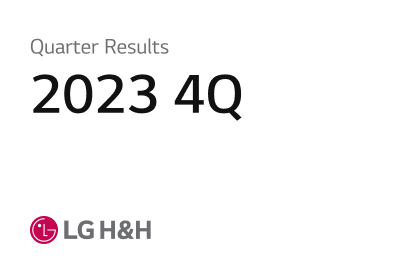Press Release
Sustainability Management Strategy
Risk Management
It is with our CEO’s firm commitment to making LG H&H more resistant to external shocks that we operate an integrated company-wide risk management system. Business segment-specific risks are monitored regularly and non-financial risks are diagnosed by internal experts to be addressed more appropriately. In addition, operational and hazardous risks in the environmental and social sectors are identified by respective functional units and are effectively managed through an organically aligned reporting system.
Integrated Risk Management Process
-
 Internal and
Internal and
external analysisMonitoring
changes in the
internal and
external business
environment Analyzing
the history of
major events
and accidents -
Understanding
crisis situations
and identifying
key risks -
 Risk Management
Risk Management
GovernanceCompany-wide crisis management committee(Company-wide integrated core risk management)
- Setting up crisis management policies
- Approving core risks
- Reviewing mitigation measures
- Supporting the implementation of company-wide perspectives
 Risk management by subcommittees* and functional departments
Risk management by subcommittees* and functional departments
- Identifying and evaluating risks
- Establishing and implementing risk mitigation measures
- Developing crisis response manuals
-
 Risk Management
Risk Management
Areas- Strategic/Future Risk
- Political / Economic / Social
- Market environment
- Major national policies, etc.
- Operational risk
- Environmental safety accidents
- Quality incidents
- Information security incidents
- Production interruptions, etc.
- Financial risks
- Accounting fraud
- Tax fraud
- Financial incidents, etc.
- Compliance risk
- Violation of laws and regulations
-
- PLAN
- DO
- ACT(Improvement)
- CHECK(Evaluation)
Management

* Subcommittees : 13 committees in total, including Environment & Safety, Quality & Service, Information Security, Production, Beverage Production, Purchasing, Logistics, Compliance, and Finance, to discuss issues related to their respective subcommittees. They define crises and major risks for each division, establish a response system in the event of a crisis, and conduct risk improvement activities.
Crisis Response System
After consulting with each subcommittee, we defined core crises by major categories, defined accident grades, and established a dissemination/communication system based on accident/issue levels(grades). Through the crisis management information system, we simultaneously disseminate information to management and related departments in the event of an accident and respond quickly to prevent it from escalating into a major crisis. In the event of a company-wide crisis, the ‘Company-wide Crisis Management Committee’ is converted to the ‘Emergency Response Committee’ to review and decide on agenda items for immediate and efficient response.
Integrated Risk Management System and Major Management Issues
Company-wide Crisis Management Committee
LG H&H organized the Company-wide Crisis Management Committee to improve crisis response execution and strengthen risk prevention activities from
an integrated company-wide perspective and operates it every other month.
The CRO chairs the Company-wide Crisis Management Committee for efficient decision-making, and key executives are organized as standing members and subcommittee chairs.
The Crisis Management Committee is the highest decision-making body in the company and discusses and resolves the overall operation of the crisis management system,
including determining the company-wide crisis management policy and checking the crisis response system by division.
It also selects priority risks from a company-wide perspective, discusses improvement measures for high risks identified by each subcommittee, analyzes risk phenomena,
and checks mitigation activities by ordering onsite inspections or short-term task operations as needed.
Company-wide Crisis Management Committee
* Scope of attendance adjusted according to agenda
- Environment/
Safety
Division - Quality(QA)
Division - Information
Protection
Division - IT DR*
Division*Disaster Recovery
- Purchasing
Division - Logistics
Division
- Production.
Ref Division - Production
Division - Human
Resources/
Labor
Division - Finance
Division - Compliance
Division - External
Relations
Division - Quality
(research)
Division
Non-Financial Risks
| Risk Name | Definition and Impact of Risks | Response Status | Related Departments |
|---|---|---|---|
| Climate and Environmental Risks |
Risks arising from natural disasters and changes in weather patterns due to climate change Risks resulting from policies and regulations Increased treatment costs due to expanded regulations on the transboundary movement and disposal of hazardous waste (non-recyclable plastics). |
Declare 2050 Carbon Neutrality for climate change response Continuously monitor applicability of greenhouse gas regulations Strengthen natural disaster risk management system, including manuals and scenarios Monitor regulatory trends and forecasts in product sales regions Continuously monitor domestic and international trends and regulations |
Green Management Part ESG Team |
| Human Rights Risks |
Violation of the dignity and value of individuals guaranteed by law or recognized internationally, leading to corporate reputation damage due to workplace harassment, discrimination, etc. |
Identify and address potential human rights risks through human rights impact assessments Operate Sexual Harassment/Workplace Bullying Counseling Center to remedy workplace harassment and sexual harassment Conduct workplace harassment and sexual harassment prevention training for all employees |
HR Division Labor Relations Division ESG Team |
| Global Economic and Supply Chain Risks |
Risks arising from rapid political, economic, and social changes Supply chain management crisis risks due to global regulations (such as the Supply Chain Due Diligence Act) |
Strengthen due diligence monitoring for global trends and overseas supply chain management Enhance internal communication and minimize unnecessary reporting Pioneer new markets, develop innovative new products, and conduct marketing activities |
Each Business Unit and Overseas Subsidiaries Global SCM Center |
| External Environmental Risks | Operational disruptions due to unforeseen environmental changes such as epidemics, wars, terrorism, and earthquakes, affecting raw material purchasing and plant closures |
Establish Overseas Subsidiary Crisis Response manual and enterprise-wide crisis management system |
Overseas Subsidiaries Purchasing/Logistics Division, etc. |
| Reputation Risks | Risks of losing consumer trust due to poor management, social controversies, major lawsuits, and misinformation |
Expand proactive communication through internal and external channels Establish enterprise-wide crisis management publicity manual and strengthen communication channels with external stakeholders |
PR Division |
| Safety Risks | Environmental and safety-related risks that can occur in business operations |
Invest in forklift human detection systems to prevent serious forklift accidents Conduct inspections to prevent plant fires and safety accidents Expand integrated health promotion system |
Environmental Safety Division |
| Quality Risks |
Major risks in quality management, such as harmful substances in products or insufficient active ingredient content Increased treatment costs due to expanded regulations on the transboundary movement and disposal of hazardous waste (non-recyclable plastics) |
Improve supplier change management processes Enhancing Quality Issue Management Systems and Strengthening Quality Capabilities |
QA Division Quality Management Team Consumer Reassurance Center |
| Information Protection/IT Risks | Risks of theft, loss, leakage of personal information handled within the company, hacking of information assets, and infections from viruses and malware affecting key systems |
Continuously monitor domestic and international information protection policies Create and operate Disaster Recovery Guide manual Establish centralized document system for research institutes to prevent core information leakage Expand integrated security management system for subsidiaries |
Information Security Center |
| Intellectual Property Risks | Risks from infringements on the company's trademarks and patents |
Protect and preempt patents and trademarks Monitor misleading and exaggerated advertisements |
Intellectual Property Division |
| Customer Risks |
Risks in managing domestic and international customer information regulations and protection measures, complaints handling, and compensation policies Risks of reduced demand and behavioral changes due to customer preference for low-carbon products |
Establish and strengthen integrated management system and monitoring for domestic and international customer claims Introduce self-service using answer bots and apply AI technology for customer consultations Enhance eco-friendly corporate image by expanding green product development Monitor regulatory trends and expand internal control systems |
Consumer Reassurance Center |
| Regulatory Compliance Risks | Risks arising from violations of major regulations, including fair trade, privacy protection, product quality, HR and labor, environmental and safety, and intellectual property |
Identify and prepare for key risks Send compliance newsletters to all employees to ensure legal compliance |
Legal Division External Cooperation Team |
Financial Risks
| Risk Name | Risk Definition | Response Status | Relevant department |
|---|---|---|---|
| Accounting Fraud Risks | Risk of embezzlement or other accounting irregularities by internal employees |
Expanding the consolidated internal accounting management system Monitoring financial statements and financial ratios of small subsidiaries Conducting on-site inspections of overseas subsidiaries |
Accounting Division |
| Liquidity Risks |
Funding risks arising from temporary shortage of liquid funds Future market instability and sudden volatility, such as sudden exchange rate fluctuations, interest rate fluctuations, capital risk, credit risk, tax risk, etc. Market instability and sharp volatility |
Monitoring macroeconomic conditions, including short-, medium-, and long-term funding plans in foreign currencies Long-term management of financial liabilities and financial assets through analysis and review of cash outflow budgets and actual cash outflows |
Accounting Division |
| Tax Risks | Tax risks in business |
Enhancing expertise by hiring tax experts Establishing a process to review taxes before making major decisions |
Tax Trade Division |


